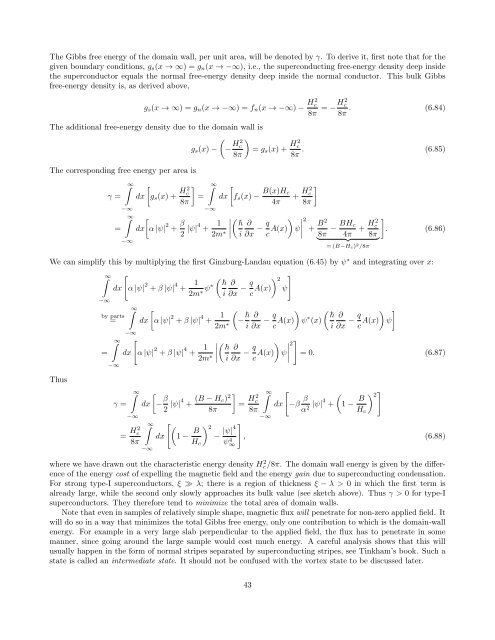Carsten Timm: Theory of superconductivity
Carsten Timm: Theory of superconductivity
Carsten Timm: Theory of superconductivity
You also want an ePaper? Increase the reach of your titles
YUMPU automatically turns print PDFs into web optimized ePapers that Google loves.
The Gibbs free energy <strong>of</strong> the domain wall, per unit area, will be denoted by γ. To derive it, first note that for the<br />
given boundary conditions, g s (x → ∞) = g n (x → −∞), i.e., the superconducting free-energy density deep inside<br />
the superconductor equals the normal free-energy density deep inside the normal conductor. This bulk Gibbs<br />
free-energy density is, as derived above,<br />
g s (x → ∞) = g n (x → −∞) = f n (x → −∞) − H2 c<br />
8π = −H2 c<br />
8π . (6.84)<br />
The additional free-energy density due to the domain wall is<br />
( )<br />
g s (x) − − H2 c<br />
= g s (x) + H2 c<br />
8π<br />
8π . (6.85)<br />
The corresponding free energy per area is<br />
γ =<br />
=<br />
∫ ∞<br />
−∞<br />
∫ ∞<br />
−∞<br />
[<br />
]<br />
dx g s (x) + H2 c<br />
=<br />
8π<br />
∫ ∞<br />
−∞<br />
[<br />
dx α |ψ| 2 + β 2 |ψ|4 + 1 ∣( ∣∣∣ <br />
2m ∗ i<br />
[<br />
dx f s (x) − B(x)H ]<br />
c<br />
+ H2 c<br />
4π 8π<br />
∂<br />
∂x − q )<br />
c A(x)<br />
ψ<br />
∣<br />
8π − BH ]<br />
c<br />
4π<br />
+ H2 c<br />
. (6.86)<br />
} {{<br />
8π<br />
}<br />
= (B−H c) 2 /8π<br />
2<br />
+ B2<br />
We can simplify this by multiplying the first Ginzburg-Landau equation (6.45) by ψ ∗ and integrating over x:<br />
∫ ∞<br />
−∞<br />
dx<br />
by parts<br />
=<br />
=<br />
∫ ∞<br />
−∞<br />
[<br />
α |ψ| 2 + β |ψ| 4 + 1 ( ∂<br />
2m ∗ ψ∗ i ∂x − q ) ] 2<br />
c A(x) ψ<br />
∫ ∞<br />
−∞<br />
[<br />
dx α |ψ| 2 + β |ψ| 4 + 1 (− 2m ∗ i<br />
∂<br />
∂x − q ) ( <br />
c A(x) ψ ∗ (x)<br />
i<br />
∂<br />
∂x − q ) ]<br />
c A(x) ψ<br />
[<br />
dx α |ψ| 2 + β |ψ| 4 + 1 ∣( ∣∣∣ ∂<br />
2m ∗ i ∂x − q )<br />
c A(x) ]<br />
ψ∣<br />
= 0. (6.87)<br />
∣2<br />
Thus<br />
∫ ∞<br />
γ = dx<br />
[− β 2 |ψ|4 + (B − H c) 2 ]<br />
8π<br />
−∞<br />
= H2 c<br />
8π<br />
∫ ∞<br />
−∞<br />
= H2 c<br />
8π<br />
∫ ∞<br />
−∞<br />
[<br />
dx −β β α 2 |ψ|4 +<br />
(1 − B ) ] 2<br />
H c<br />
[ (<br />
dx 1 − B ) ]<br />
2<br />
− |ψ|4 , (6.88)<br />
H c<br />
ψ 4 ∞<br />
where we have drawn out the characteristic energy density H 2 c /8π. The domain wall energy is given by the difference<br />
<strong>of</strong> the energy cost <strong>of</strong> expelling the magnetic field and the energy gain due to superconducting condensation.<br />
For strong type-I superconductors, ξ ≫ λ; there is a region <strong>of</strong> thickness ξ − λ > 0 in which the first term is<br />
already large, while the second only slowly approaches its bulk value (see sketch above). Thus γ > 0 for type-I<br />
superconductors. They therefore tend to minimize the total area <strong>of</strong> domain walls.<br />
Note that even in samples <strong>of</strong> relatively simple shape, magnetic flux will penetrate for non-zero applied field. It<br />
will do so in a way that minimizes the total Gibbs free energy, only one contribution to which is the domain-wall<br />
energy. For example in a very large slab perpendicular to the applied field, the flux has to penetrate in some<br />
manner, since going around the large sample would cost much energy. A careful analysis shows that this will<br />
usually happen in the form <strong>of</strong> normal stripes separated by superconducting stripes, see Tinkham’s book. Such a<br />
state is called an intermediate state. It should not be confused with the vortex state to be discussed later.<br />
43

















